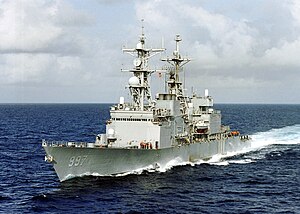USS Hayler

| |
| History | |
|---|---|
| Namesake | Robert W. Hayler |
| Ordered | 29 September 1979 |
| Builder | Ingalls Shipbuilding |
| Laid down | 20 October 1980 |
| Launched | 2 March 1982 |
| Sponsored by | Nicole Hayler, granddaughter of namesake |
| Acquired | 10 February 1983 |
| Commissioned | 5 March 1983 |
| Decommissioned | 25 August 2003 |
| Stricken | 6 April 2004 |
| Motto | Courageous in Conflict |
| Fate | Sunk as a target, 13 November 2004 |
| Badge |  |
| General characteristics | |
| Class and type | Spruance class destroyer |
| Displacement | Template:Spruance class destroyer displacement |
| Length | Template:Spruance class destroyer length |
| Beam | Template:Spruance class destroyer beam |
| Draft | Template:Spruance class destroyer draft |
| Propulsion | Template:Spruance class destroyer propulsion |
| Speed | Template:Spruance class destroyer speed |
| Range | Template:Spruance class destroyer range |
| Complement | Template:Spruance class destroyer complement |
| Sensors and processing systems |
|
| Electronic warfare & decoys |
|
| Armament | Template:Spruance class destroyer armament VLS |
| Aircraft carried | Template:Spruance class destroyer aircraft |
USS Hayler (DD-997), the last Spruance-class destroyer, was the first ship of the United States Navy to be named for Vice Admiral Robert W. Hayler (1891–1980).
History
For fiscal year 1978, Congress authorized the production of two additional Spruance-class destroyers, though they funded only one. These were intended to be built as helicopter destroyers (DDH), provided they would not cost more than a standard Spruance-class. Litton-Ingalls completed sketch design work for DDH-997, which moved the helicopter deck aft, stretching the length of the hangar and displacing the Sea Sparrow launcher to the top of the hangar. The design would have accommodated two SH-3 Sea Kings or four smaller SH-60 Seahawk or SH-2 Seasprite helicopters. While the prospective DDH-997 probably wouldn't have cost much more to build than a standard Spruance-class, the detail design and engineering work required before the ship could be built would have been substantial (similar work for the Kidd-class cost $110.8 million). This raised the cost of the DDH substantially above a standard Spruance-class destroyer. While this additional cost might have been justified if the DDH was going to enter series production, it was difficult to justify for a single ship. Accordingly, the Navy built Hayler to a similar design as the rest of the class, while incorporating some systems from the Ticonderoga Cruiser and Kidd Destroyer designs.
Hayler was laid down on 20 October 1980 by Ingalls Shipbuilding, in Pascagoula, Miss.; launched on 2 March 1982; and commissioned on 5 March 1983.
Service
On 23 October 1988, Hayler was in collision with the West German replenishment tanker Rhön. Hayler was badly damaged aft, and was under repair at Rosyth Dockyard, Scotland, until 20 November.[1]
The ship was assigned escort duties for the USS La Moure County (LST-1194) as it accidentally ran aground near the coast of Caleta Cifuncho Bay, Chile in the pre-dawn hours of 12 September 2000 during a routine amphibious training operation with a sister vessel, the Chilean Valdiva.
Fate
Hayler was decommissioned 25 August 2003 at Norfolk Naval Shipyard, Portsmouth, Va. She was stricken from the Naval Vessel Register on 6 April 2004 and sunk as a target on 13 November 2004, during the 2004 Sink Exercise.
Ship's crest
According to the U.S. Navy, Hayler's crest is representative of Vice Admiral Hayler's inspiring leadership, his dedication to his country, his proficiency as a naval officer, and of the history and traditions of the naval service.[2]
The gold stars on the blue background in the upper area of the shield symbolize the many Pacific Island Campaigns Admiral Hayler participated in as a Commanding Officer, and as a Commander of a cruiser division during World War II. The stars also represent the numerous awards he received, some repeated two and three times. The chevron is a symbol of strength and support, and the blue crosses represent the Admirals's three Navy Crosses, an award for valour exceeded only by the Medal of Honor.[2]
The crossed red battle axes are a symbol of strength and resourcefulness under fire, and represent Admiral Hayler's wartime service. The two stars they bear are in recognition of the Silver and Bronze Stars awarded to Admiral Hayler for valour. The bomb represents naval firepower, gunfire support and anti-aircraft fire, and symbolizes the contributions of Admiral Hayler to the development of naval ordnance at the outbreak of World War II.[2]
The anchor refers to the fleet, and Admiral Hayler's efforts toward its strength and safety. The predominant colors, red, white, and blue, are representative of the national flag, and Admiral Hayler's patriotism and loyalty to the flag and the nation it represents.[2]
The ship’s motto "Courageous in Conflict" exemplifies the ardent professionalism and steadfast leadership that characterized Vice Admiral Hayler’s career and now serves as the watchword to guide HAYLER sailors.[2]
See also
References
![]() This article incorporates public domain material from USS Hayler (DD-997) Ship's Crest. United States Navy.
This article incorporates public domain material from USS Hayler (DD-997) Ship's Crest. United States Navy.
- ^ Sturton 1989, p. 247
- ^ a b c d e "Ship's Crest". USS Hayler (DD-997). Archived from the original on 8 June 2001.
- Sturton, Ian (1989). "The Naval Year in Review: F (ii). Major Casualties at Sea From 1 April 1988 to 30 April 1989". In Gardiner, Robert (ed.). Warship 1989. London: Conway Maritime Press. pp. 247–249. ISBN 0-85177-530-6.


